In a matter of just four months last semester, students: sifted through fossils like 19th-century naturalists, presented a U.S. monetary policy to the Federal Reserve, and fact-checked Vladimir Putin — not to mention the caretaking of 2,000 red wiggler worms.
To experience what it’s like to take a Colgate course these days, lace up your hiking boots, jump into a University van, and ride to a nearby quarry for your first class, Geology Outdoors.
Field Notes
Geology Outdoors (Geol 110/FSEM 177)
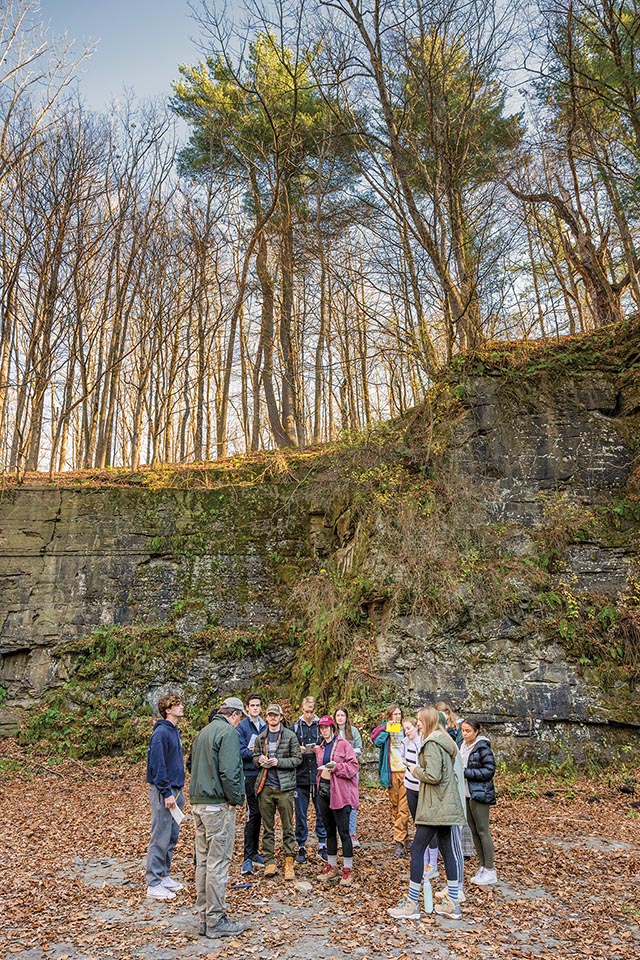
You found a trilobutt,” Professor William Peck tells Madison Cammarata ’26, as other students gather to look.
“You found a trilobutt? The butt of a trilobite?” one student wisecracks.
And yet, that is, basically, what Cammarata discovered.
“You see the little spines? That’s the Greenop’s pygidium [posterior],” Peck explains. “Good eye.”
In a hidden quarry near Lebanon Reservoir, 15 minutes from Hamilton, these types of exchanges — alternated with excited exclamations when fossils are found — pop up throughout the two-hour class.
The 14 students clamber up and slide down mounds of shale as they scan the ground, rummage through rocks, and gather their treasures.
Boots, or at least rugged sneakers, are required. So is an inquisitive nature.
“If we find a lot of these rocks were oxidized, it probably means they had oxygen while the rocks were forming, right?” Alexis Rodgers ’26 asks Stella Strassburg ’26.
The students bounce ideas off of their partners while scribbling field notes. Peck poses questions to the larger group: “What site is this most like?” he asks, prompting the class to compare the quarry to their earlier trips to look at sedimentary rocks near Morrisville, Munnsville, and Clinton. “Why are there so many fossils here?” Peck inquires further. This quarry in the town of Eaton, filled with brachiopods, bivalves, coral, and trilobites, shows the ecosystem of the shallow sea that covered central New York during the mid-Devonian times, he explains.
Peck wants his students to adopt the mindset of 19th-century naturalists in the field, articulating their observations and posing hypotheses about the rocks, rivers, and landscapes they visit each week. They then consult their textbooks and take in a wider perspective from Google Earth before hunkering down to write a 3,000-word paper on each subject. “They’re looking at their data and trying to pull out a story,” explains Peck, who has been teaching the course for approximately 14 years. “That idea that you can come up with a big story out of small- to medium-sized observations, it really speaks to them. It’s a powerful insight.”
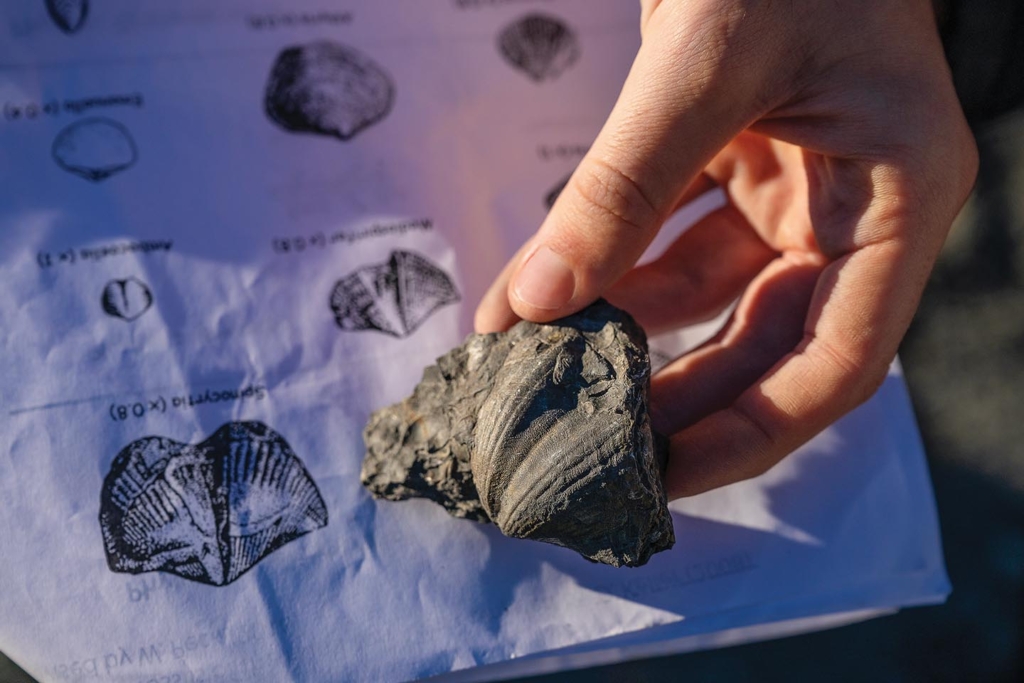
Brachiopod Spinocyrtia
Back in the quarry, Ben Mitchell ’26 finds a brachiopod. “Oh, that’s a good one,” Peck says. “That’s beautiful. I love the razor look of the Mucrospirifer.”
Open-book test: What’s the difference between a brachiopod and a bivalve? “If you put a mirror down the middle of a brachiopod, the right and the left would be the same,” Peck says. “They all have a mirror plane. But if you imagine a bivalve, like an oyster, they’re all curved.”
Did you know? Trilobites can be found on the Seven Oaks driving range. Professor William Peck’s student Ben Mitchell ’26 recently found one. In this issue’s Discover section, paleontologist Christy Visaggi ’02 remembers when she discovered them there as a student.
‘We’re Going to Be Policymakers Today’
Fed Challenge (Econ 353)
Inflation is on everyone’s minds and mouths right now. While most of us are digesting the topic in our daily news reports, students in Professor Michael Connolly’s class were eating it for breakfast, lunch, and dinner last fall.
To prepare for the 2022 College Fed Challenge — a nationwide competition — Connolly’s students spent the semester analyzing economic and financial conditions in order to present a monetary policy recommendation to the Federal Reserve.
“From the first few weeks, it was a sprint to the finish,” Connolly says.
“It really did go from 0 to 60, starting early on,” confirms Nikola Duka ’24, an economics major from Worcester, Mass.
In the beginning of the semester, the class voted on who would comprise the five-person presentation team and who would be on the research team.
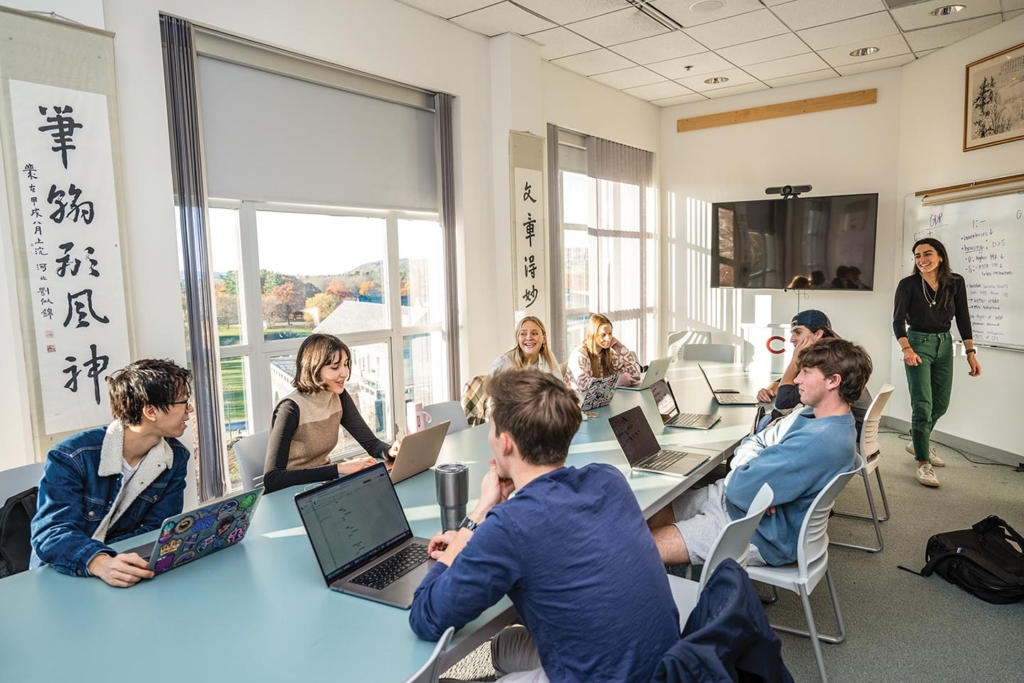
The class then spent a month reading, analyzing, deliberating, and practicing. “I push my students; I don’t hold back,” Connolly asserts. “I say, ‘We’re going to be policymakers today.’”
On Oct. 6, they submitted their 15-minute video presentation for the first round of competition. “Basically, they covered the key themes that the Fed cares about: inflation, labor market, real economy, financial markets,” Connolly explains, “and then they made a policy proposal based on different scenarios that might occur going forward.”
If the team were to succeed, they’d advance to the second, and final, round. “It was really well done,” Connolly says.
Turns out, the Fed agreed. The morning of Nov. 9, the presentation team logged on to Zoom, preparing to be grilled for 15 minutes by four judges from the Fed while their professor and research teammates watched. They listened to the intro and told the judges their team number — assigned, to retain anonymity in the 18-team finals. The group’s strategy involved splitting into “tortoises” and “hares.” “Hares would jump on the question; they would give a broad overview and give the tortoises time to think,” explains Duka, a tortoise.
Max Parrott ’24, who was also a tortoise, adds: “We divided it into inflation, labor, finance/policy, and output. We had two tortoises and one hare for each, but with an understanding that we’ve all looked at the topics so much that if someone missed something, anyone else could jump in. There’s a bit of an art to it.”
Afterward, still trying to remember all that happened in the rapid-fire round, Duka reflects, “It was intense.” Still, the group felt prepared. “There was nothing that we hadn’t discussed at least once,” adds Parrott, an economics major from Bedford, N.Y. “I was really proud of the team.”
As campus was about to depart for Thanksgiving break, the team learned that they won first place in the New York District; the other finalists were Rutgers-New Brunswick and SUNY Geneseo. The Colgate team also received an honorable mention in the nationals, alongside University of Notre Dame and UCLA.
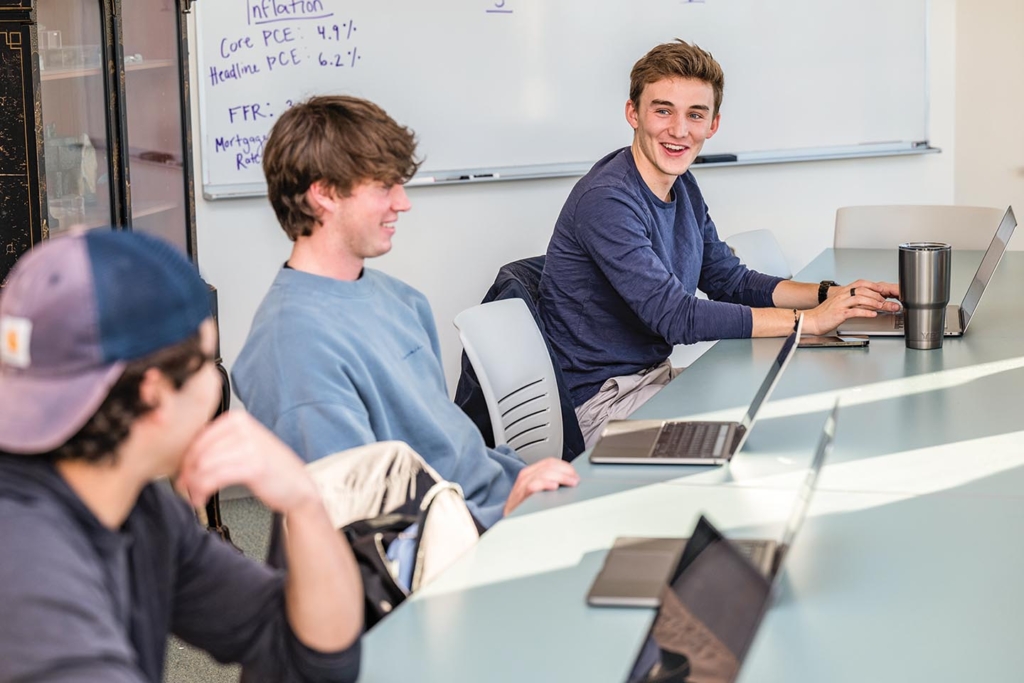
“They put in a tremendous amount of work this semester and it paid off,” Connolly says.
Parrott concludes: “It’s by far the most I’ve ever walked away from a class where I’ve thought, ‘Not only do I feel like I learned about this economic topic, but I also understand the world a lot better.’”
More about the professor: Connolly taught Fed Challenge for the first time in the fall, but it wasn’t his first experience with the competition. He competed twice as a student at Rutgers, where his team made it to the finals both times. “It was the most rewarding experience of my undergraduate education,” he says. “Seeing how much that mattered for my career and my friends who competed, I knew this had tremendous value,” adds Connolly, whose first job after college was at the Federal Reserve Bank of Kansas City.
Colgate has advanced in the Fed Challenge twice in previous years. In 2019 the team earned second place for the New York district. The 2017 team received an honorable mention for the New York district.
Book Lovers Unite
A passion for reading is the only prerequisite, according to the syllabi for Professor Jennifer Brice’s Living Writers classes.
That requirement resonates with Leah (Werner) ’96 Schultz, who has been participating in the course every year since she took it as a student with Professor Frederick Busch.
“I like reading a lot,” says Schultz, who was one of approximately 6,500 alumni, parents, and community members signed up for the fall not-for-credit program. “And I like being introduced to books I normally wouldn’t stumble across.”
This year was special for Schultz because she took the course with her daughter, Lily ’26. Leah had recommended it, saying, “Even if you’re not going to be an English major, it’s very interesting for writing in general, which is important at Colgate.” Throughout the semester, they’d see each other on Zoom in some of the open sessions, and they’d discuss the books privately.
The course has changed since Leah was a junior, with more opportunities now for students to interact with the authors, as well as a podcast, a website, and Monday-evening Zoom sessions featuring faculty members who can speak to that week’s topic.
“It’s sort of flipping the classroom,” Brice says. “They read the book, they have a really intense conversation with me about it, but they’re also expected to listen to the podcast, come to Zoom discussions, and read book reviews, interviews, and biographies — it’s a lot of work.”
For Lily, it’s paying off: “It’s been making me appreciate the books I’m reading a lot more,” she says. “I’m learning what questions to be asking about literature and how to analyze it from the standpoint of not just the reader, but also what the author might have been thinking when they were writing.”
Brice spends significant class time on how to prepare questions for the authors, pushing students to be specific. “No lazy questions,” the professor emphasizes.
For Leah, it’s about more than the books: “It’s the community,” she says. “The feeling that I’m still involved in Colgate…. It’s a connection back to the school, and I’m doing something I love to do.”
Fall ’22 readings
This year, in addition to the usual 300-level Living Writers course, Brice offered it as an FSEM. In that version of the class, students read a slightly abridged version of the full 10-book list.
Severance, Ling Ma
The Crane Wife, CJ Hauser
How Beautiful We Were, Imbolo Mbue
The Stone Loves the World, Brian Hall
A Small Place, Jamaica Kincaid
Essex Clay, Sir Andrew Motion
What We Talk About When We Talk About Anne Frank, Nathan Englander
Tentacle, Rita Indiana
Possessing Harriet, Kyle Bass
Weather, Jenny Offill
The Linked World
Networks: Friends, Terrorists, and Epidemics (Core S195)
Six degrees of Kevin Bacon — it’s a well-known concept. But that basic principle, when applied through network science, has the ability to extend our knowledge far beyond simply connecting actors in movies. Researchers can predict the spread of disease, find terrorists, and comprehend complex financial systems, just to cite a few examples.
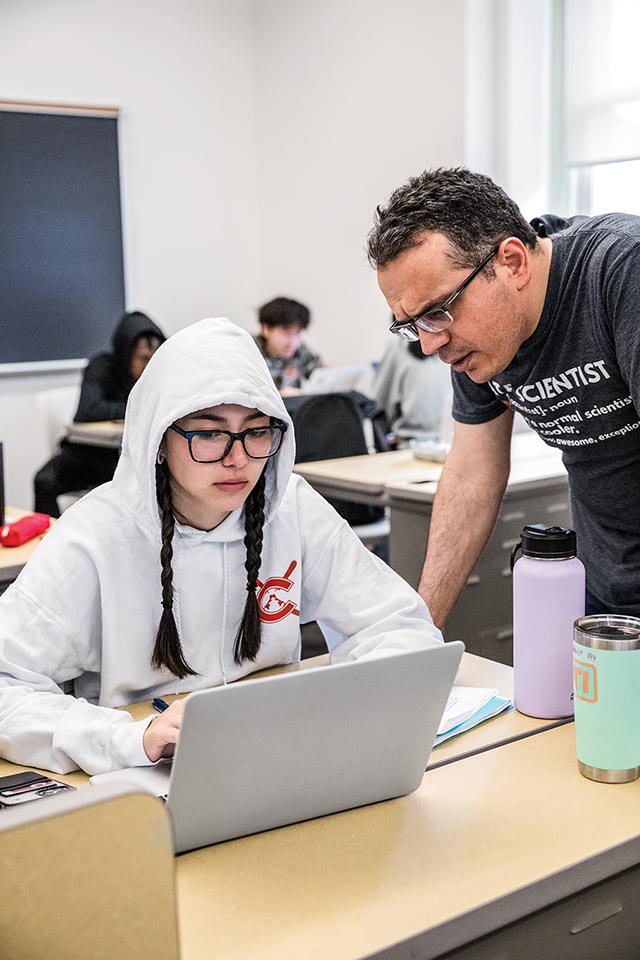
Graph theory, a branch of mathematics used in network science, plots out the relationship between nodes (or vertices) and links (or edges). Using Facebook as an example, Professor Ahmet Ay explains: “People are the nodes and their friendships are links.”
In his class, Ay and his students analyzed data to make conclusions about a variety of situations, ranging from the fantasy realm to the theoretical to actual global events. They created a Game of Thrones network by scanning the books to see how closely characters are located to each other in the text (within 15 words), measuring characters’ centrality by noting how many links that person has, and ultimately deducing which character is the most important in each book.
Using a real-world example, the class looked at the 2008 Mumbai terrorist attacks. “The ideal terrorist networks are star-shaped,” Ay explains. “There is one key person in the middle who talks to everyone, but they try to reduce the amount of talking between the other members so that the information will not get out.”
A biologist as well as a mathematician, Ay is most interested in biological networks. “If you want to cure diseases and understand
how to develop a drug, you have to look at how it would impact the rest of the system,” he says. “So you need to know the connections between the genes and how changing one of them will have an effect.”
For their take-home project, each student chose a data set to analyze. One student scrutinized the corruption in the Mexican political system. Another compared the dolphin social network to humans.
Available data sets were one option for students, or they could collect their own. Kas Betinol ’24 gathered data, confidentially, from a Colgate varsity team to determine who would be the best fit for captain. “I was able to calculate [players’] positions in the network, their popularity, and how well they were connected to other well-connected people,” she says, “trying to find out who would be the best leader for the team.” In her findings, Betinol learned that the top two candidates for this (anonymous) team’s leaders were the student-athletes with the highest scores on their ability to influence others.
“The idea is to learn about life from these different networks,” Ay says.
A critical takeaway from network science is that we’re all more closely related than we realize. Rather than six degrees of separation, it’s been shown that strangers can actually be connected in three to four links on Facebook. “We call this the ultra-small world effect,” Ay says.
We’ve Got the Funk
Funky Stories: Memoirs and Black Popular Music (alst 313)
Every time Professor Scot Brown hears “Strawberry Letter 23” by the Brothers Johnson, he smells strawberries. Brown was in sixth grade when the song came out on 45. With a prized dollar, he walked to his neighborhood music store in Rochester, N.Y., where he proudly purchased the record. The label in the center of the 45 had a strawberry-fragranced scratch-and-sniff coating, which Brown still remembers today.
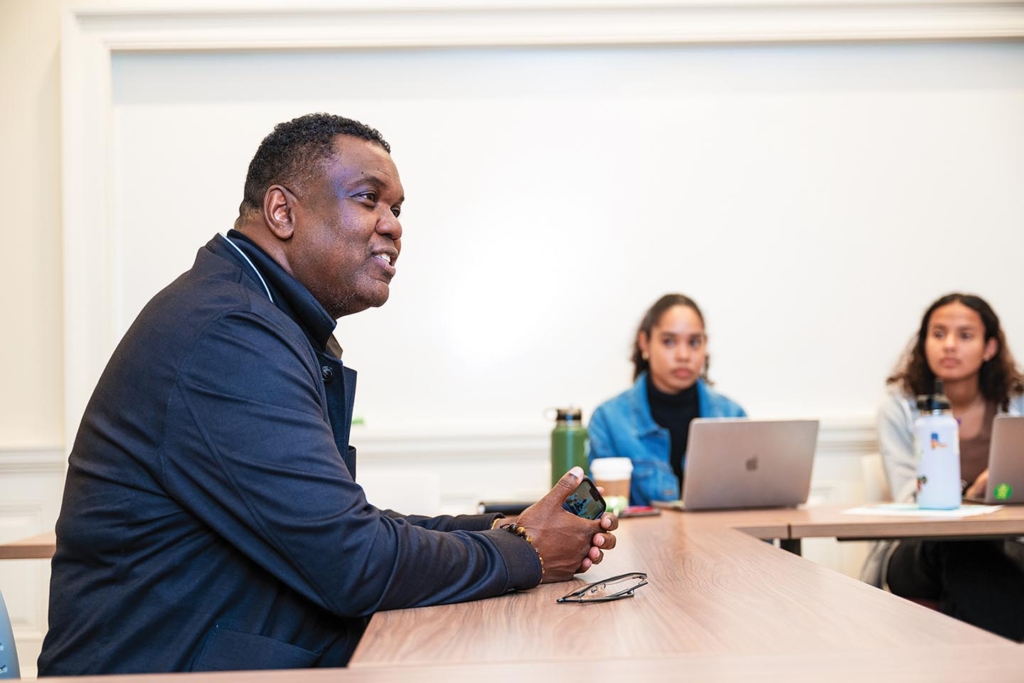
In Brown’s Funky Stories class, “students gain a greater understanding about the power of music in our lives,” he says of the course taught in the fall and again this spring.
They read books about musicians like Maurice White, Grace Jones, George Clinton, and Faith Evans. “The course is an engagement with those memoirs,” Brown says, “for learning the methodologies and techniques of incorporating and infusing sound, life experience, and visual references to music [into writing].”
Students also learn the connections between music, social politics, and historical contexts. “They’re getting urban history, and they’re getting stories about Black communities, which these artists are from … in many different environments and contexts.”
For the final project, students create their own music memoirs, reflecting on their personal experiences with sound in a multimedia essay about their life experience. Brown says it’s important to him that his students work on a project that has “life value.” He adds, “So that they’re getting a journey that’s very rich and, at the same time, they come out of it, hopefully, with some techniques they can use and deploy beyond this classroom.”
Fact-Checking Putin
Russia at the Crossroads (Core C187)
When thinking about how to approach her Core Russia course last fall, Alice Nakhimovsky knew the Russian invasion of Ukraine “had to come front and center,” she says.
The class began with the history of Ukraine and Russia and then looked at how Vladimir Putin presents that past. “The origin story of Ukraine versus Russia is murky because it is the distant past and interpreted differently [by Putin versus Ukraine],” Nakhimovsky says. “In other words, is Kyiv the origin of Russia or the origin of Ukraine?”
To take a closer look at the truthfulness of Putin’s narrative, the professor asked her students to fact-check his essay “On the Historical Unity of Russians and Ukrainians,” published on the Kremlin’s website in 2021. The essay “elaborates on his frequently stated assertion that Ukrainians and Russians are ‘one people,’” explains Harvard’s Ukrainian Research Institute.
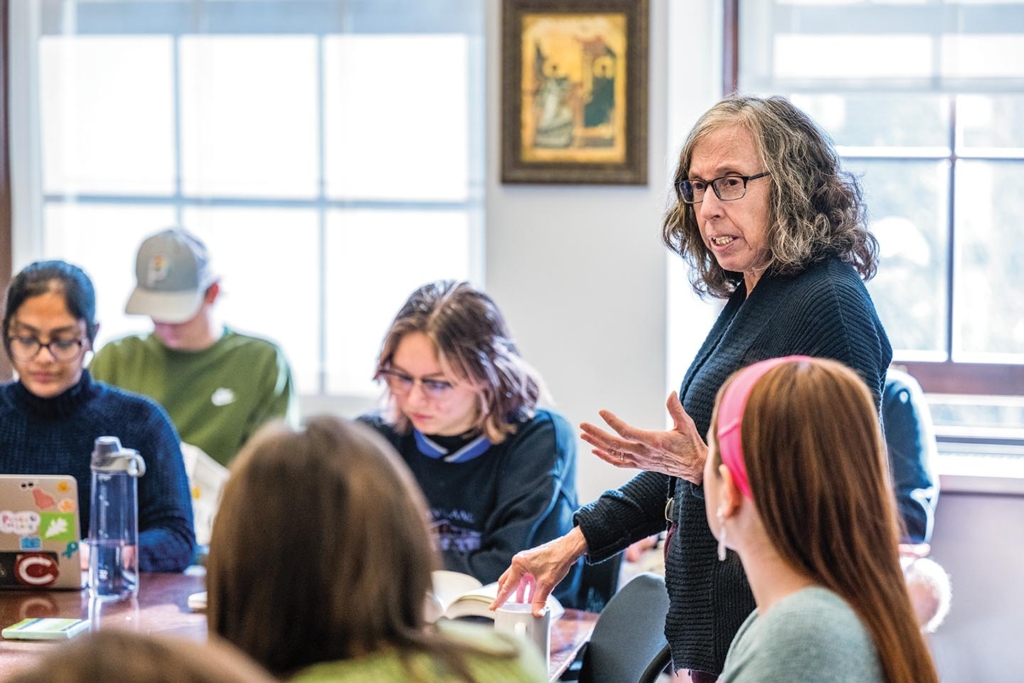
“We looked at how [Putin] perpetuated Russian creation myths and how that gave a false narrative of how Ukraine is tied to Russia,” says Ethan Hamlin ’25. “He would bring up a lot of religious symbolism to evoke that feeling of unity between Russia and Ukraine because he basically wanted to give the Russian people a sense that they had some sort of ownership over Ukraine, in order to justify trying to occupy them.”
Nakhimovsky estimates that she’s been teaching the class for 35 years, and although it’s changed throughout the decades, it’s always provided a historical perspective of Russia. “A lot of the world’s crises seem to emanate from there,” she says. “So it’s worth knowing about in all its complexity.”
In addition, Core Russia delves into the role of literature and art as it relates to the history and politics of the region. As the syllabus outlines: In Gogol, we have bureaucracy … and the little man. In Dostoevsky, we have a philosophical reaction against liberalism and an examination of human nature — all against the background of Russian bureaucracy.
“Literature is a way of examining people in society,” Nakhimovsky says. “[It] often gets overlooked as peripheral, and I don’t think it’s peripheral. I think it can be highly explanatory.”
Hamlin decided to enroll in Core Russia after taking Nakhimovsky’s Russian literature class in spring 2022. “I learned a lot, and it made me curious about Russian history in general,” he says.
“Professor Nakhimovsky’s classes are very interdisciplinary — we read textbooks, we watch videos, we listen to music. That type of well-rounded syllabus makes it easier to tie the class into other classes in unexpected ways.”
Enlightenment
Ethics (Philosophy 111)
Are ethics rooted in God?
Is morality objective?
What obligations do we have to others?
These are some of the questions Professor David McCabe explores with students as an introduction to ethics and philosophy.
“We talk about big-scale issues, and then I hope to have said enough about them so that the students actually can work out for themselves which normative theory they think is correct,” McCabe, who is the Richard J. and Joan Head Chair in philosophy, says. “A normative ethical theory fundamentally answers questions about what makes acts right and wrong, and, in doing so, it will often give us an account of what is a good life, what is of value in a human life.” That last question, McCabe says, presents the chance for students to ask probing questions at a time in their lives when they’re formulating ideas that shape their adult selves.
Students discuss their own views in class and also study what McCabe calls “the various candidates that have stood the test of time”: utilitarianism, the ethical thought of Immanuel Kant, and virtue ethics, which is rooted in Aristotle.
The goal is for students to know the various arguments “and decide for themselves,” he says.
But whatever they decide, students should acknowledge that all the views they encounter “have great strengths and serious weaknesses,” he emphasizes.
That’s why philosophy is so important now: “There’s a tendency to demonize people we disagree with, who are on the other sides of issues. We’re finding it harder and harder to talk with each other and easier and easier simply to dismiss people who disagree.”
By acknowledging the complexities and challenges with all of the views discussed, “the result of it, I think — this is true of philosophy generally — is to instill a certain kind of humility in people,” he says. “The study of philosophy, if it’s done properly, should work to open your mind to ideas you might have rejected too hastily.”
To that point, McCabe last fall expanded what has been traditionally taught in the class and spent time discussing “issues students are especially interested in now, which are race and gender.”
Including these areas, as well as current topics like abortion, “seems to me an important thing to do,” McCabe says, “to let students see quite directly how the abstract ethical reflection that we’re carrying out in the class should affect the ways they approach the various challenges in their lives.”
Black Gold
Eco-Art (FSEM 160)
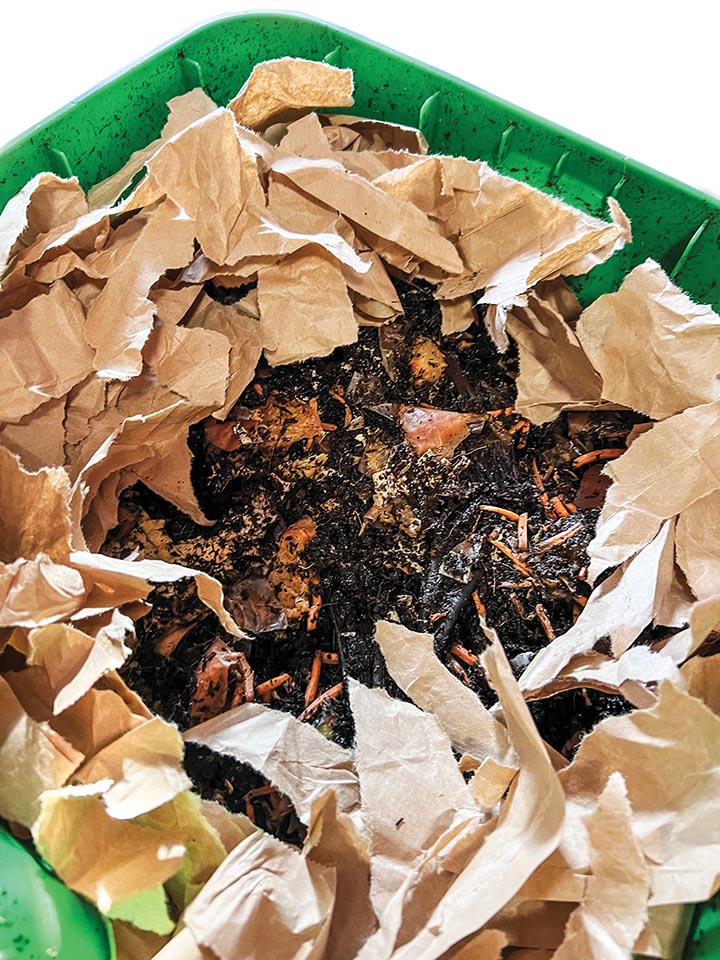
At the end of dinner at Frank Dining Hall, Kim Gates ’26 fills a cup with a piece of watermelon, a carrot, and some cereal. It’s
not a snack for later — it’s for her pet worms.
She returns to her Drake Hall common room, where she chops the food into tiny bits and sprinkles it into a bin filled with hundreds of red wigglers that have been waiting for their weekly feeding. Then she’ll rip paper into shreds for the bin and spray it all with water. “We have to make sure the bins are moist,” Gates says. She and her group members from Eco-Art take turns or team up to care for the worms.
Ecological art is a contemporary social arts practice that brings living things into relationship with one another, the syllabus explains. “I wanted the students to have a process-based engagement with something beyond the human,” says Professor Margaretha Haughwout. “The worm bins seemed like a great way to do that and to have collaboration between the students.”
The class groups cared for three bins that began with a total of 2,000 worms. (“If they’re doing well, they’ll multiply,” Haughwout says.) The compact containers — only a couple of feet in width and height — ultimately produced compost for Haughwout’s Food Forest Studio at the Paul J. Schupf ’58 Studio Arts Center. “In permaculture circles, we call [vermicompost] ‘black gold’ because it’s incredibly nutritious and really good for your gardens,” Haughwout says.
Students have told her that it’s been a meaningful project, to have something to care for that’s not just themselves.
Gates also sees it as an easy sustainability effort. “These ways that don’t take much of our time or energy — it just goes to show the little simple measures that we can take to do things for the environment.”
